Computex 2005 Day 2 - ULi's new Athlon 64 Chipset, G70, CrossFire & more
by Anand Lal Shimpi on June 1, 2005 1:57 AM EST- Posted in
- Trade Shows
ULi - The Best Kept Secret of Taiwan?
About two years ago failing chipset maker ALi dropped out of the chipset business and a spinoff, ULi, took over. ALi reached the height of their popularity during the Socket-7 days, but when Intel transitioned to their Slot-1 architecture ALi began to lose ground. While ALi was one of the first to show working Athlon 64 chipsets, their K8 solutions were hardly adopted and thus the market was given away to SiS, VIA and of course, NVIDIA.
ULi’s existence was supposed to change all of that. Focusing on stability and reliability, two issues that ALi’s chipsets proved to have later on in their life, ULi was determined to create a chipset business that would be among the best.
Currently ULi has manufacturers like ASUS, ABIT and ECS making boards based on their chipsets, yet none of the sales people from those companies will sell ULi based motherboards into the North American and European markets. In the Chinese markets, the ULi based boards sell extremely well. The chipsets themselves are priced lower than VIA’s, yet are quite competitive with NVIDIA’s nForce4 Ultra solution. The problem is branding; ULi has no brand recognition in the Europe and North American markets, thus selling motherboards based on their chipsets becomes quite difficult.
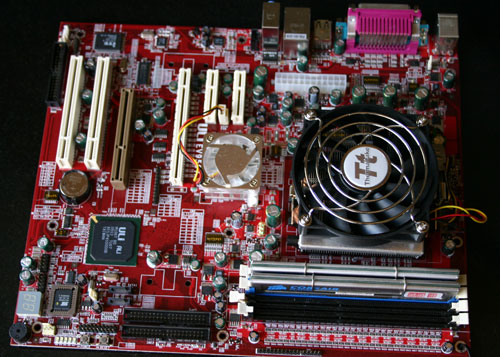
We took a look at a ULi Socket-939 PCI Express reference board while in Taiwan to see if what ULi was telling us happened to be true. Could ULi’s chipsets offer performance close to that of NVIDIA, while also offering stability at a price point lower than VIA’s?
We ran a small suite of tests on ASUS’ AN8-SLI Deluxe (nForce4 SLI) as well as ULi’s Socket-939 PCI Express Reference Motherboard. The performance of the chipset was quite compelling; faster than the nForce4 in Doom 3, yet slower in the Winstone tests.
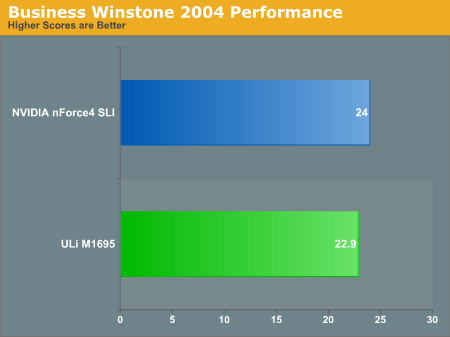
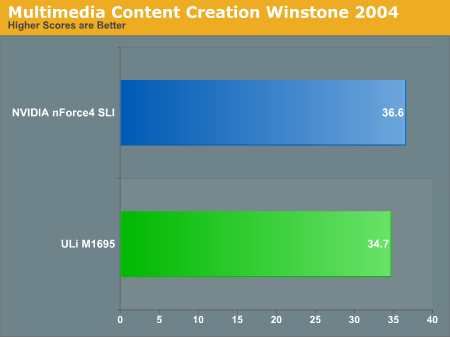
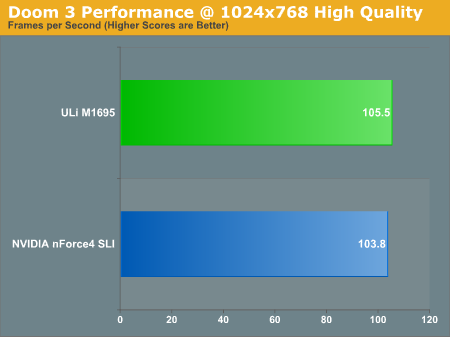
Overall performance was quite respectable, but most importantly was that we encountered no problems during our testing. Overclocking features were limited on the reference board, but we’re hearing that ABIT has a board based on ULi’s chipset that should offer some pretty good overclocking performance.
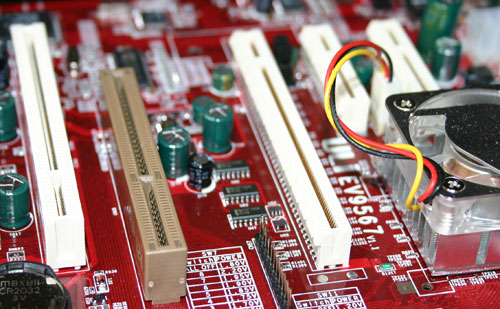
One particularly nice feature of the ULi chipset is that its South Bridge offers a full speed AGP 8X interface - and the North/South Bridges communicate over a 8GB/s Hyper Transport bus, meaning that there’s no reduction in performance if you use an AGP graphics card on the motherboard. By offering both AGP and PCI Express slots, both of which run at full speed, you can have a single motherboard that will support your current AGP graphics card and any later on PCI Express cards without sacrificing any performance.

The Current M1567 South Bridge has full AGP 8X Support
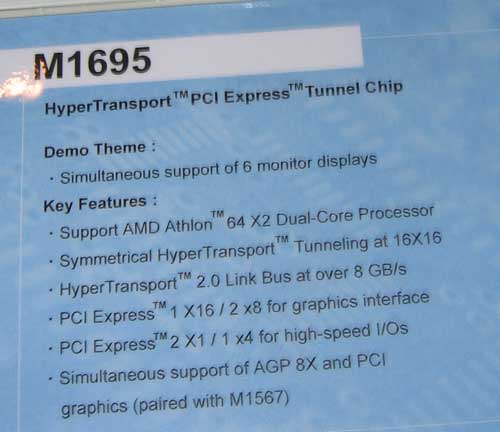
The Spec list of the M1695 ULi chipset
Currently ULi has the manufacturer support they need, they simply need to be able to improve brand recognition it seems. With the right combination of getting their name out there and a solid enthusiast-level motherboard, ULi could very well be the chipset manufacturer to pick up where VIA left off.
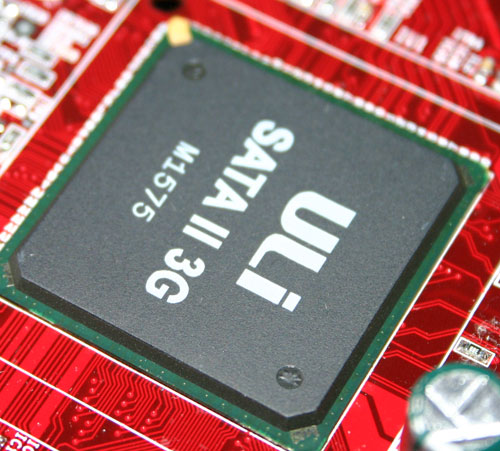
The new M1575 South Bridge will add SATA II support
Current pricing for Socket-939 motherboards based on the ULi chipset appears to be at the sub-$80 level, which isn’t bad at all for a nForce4 Ultra competitor.

ULi also makes most of the South Bridges for ATI based motherboards
We saw ULi boards from a few manufacturers at the show; ECS' board looked a lot like ULi's reference design and will carry a street price of around $75:

Jetway also had a motherboard on display:
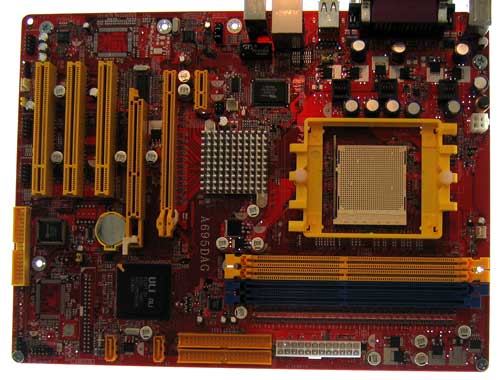
While ASUS and ABIT also have boards, we did not get a chance to take a look at them at the show.










53 Comments
View All Comments
Icehawk - Wednesday, June 1, 2005 - link
Anyone have links for more on the i-Ram? ETA on the device?I have some older DDR sticks just sitting around that are essentially worthless, seems like the i-RAM would make me a nice swap disk. Too bad it doesn't offer a port on the back for an optional wall wart though.
Also, on the AGP & PCIe boards - can you run both at the same time? Not SLI, I mean multi-monitor stuff.
EODetroit - Wednesday, June 1, 2005 - link
#38/#41... I can't wait for those iRAM things to come out.My plan: Stripe or JBOD two of those suckers with 4GB each in them together, then load my World of Warcraft files on it, then instantaneously load new zones and massive PvP battles while everyone else is lagging out!
Woohoo!
mlittl3 - Wednesday, June 1, 2005 - link
Oops, a little mistake in my post, #38. Actually a big mistake.Please ignore all the memory bandwidth numbers. I'm getting my bits mixed up with my bytes.
DDR200 -> 1600 Mbytes/s not 1600 Mbits/s
DDR333 -> 2700 Mbytes/s not 2700 Mbits/s
The SATA numbers and everything else is correct, however. I think.
Now I'm frustrated with myself. :)
gibhunter - Wednesday, June 1, 2005 - link
You people need to get hold of yourselves and calm down about ULI. They used to make the worst pos chipsets as ALI and that's why they went under. Now rebranded as ULI you think they will be any better? Let me save you the trouble. Their chipsets are still piece of shit. I have a socket 939 motherboard that's just sitting there cause it wouldn't run at high performance settings. In fact, it corrupted my winXP install halfway through intslling drivers on it. Fresh install of windows gave me all kinds of problems thanks to a driver cd that installed winME USB drivers. So much for trying to save some time. Trust me, they went under for a reason. Stay away and stay happy. I now have two other socket 939 systems on VIA and Nvidia chipsets and sailing has been nothing but smooth. Can't say that for POS ULI which even if it runs stable can't match the other two in performance.erinlegault - Wednesday, June 1, 2005 - link
I want one of those nForce 4 Pro dual socket Tyan motherboard's with dual core Opteron 2xx's.That should last a while through our current multitasking paradigm.
mlittl3 - Wednesday, June 1, 2005 - link
#13 and anyone else, please, please read this.The Gigabyte iRAM is ONLY powered by the PCI slot. No, I repeat, NO data is moved through the PCI slot. When the PC is off, the RAM is powered by the rechargable battery.
The reason for only supporting DDR200 is because data transfers through the SATA port (the iRAM is seen as a SATA hard drive by the PC) on the PCB. So the bandwidth of SATA is 150 Mbytes/s (1200 Mbits/s) and the bandwidth of DDR200 is 200 Mbytes/s (1600 Mbits/s). Any faster memory will work (DDR333, DDR400, etc.) but will be clocked at DDR200 on the iRAM because the bottleneck is the SATA transfer bandwidth.
If they move the card to SATA II, 300 Mbytes/s (2400 Mbits/s) then they will support DDR333 which has a bandwidth of 337 Mbytes/s (2700 Mbits/s).
The iRAM will have latencies of tens of nanoseconds instead of 10 milliseconds. This is three orders of magnitude (1000 times) faster.
I know no one is going to read this and I'm going to get more frustrated.
monsoon - Wednesday, June 1, 2005 - link
looking forward to real world tests of the GIGABYTE i-RAM and the ZALMAN "hamster" cooler !;)Aquila76 - Wednesday, June 1, 2005 - link
LOL. I can't help thinking the Zalman CPU cooler should have a hamster running in it!ViperV990 - Wednesday, June 1, 2005 - link
First I was wondering why there was a VGA-out on the A8N-SLI Premium, then I realized the rear I/O panel shown is not the one from the A8N. In fact, it doesn't match anything on the page.ryanv12 - Wednesday, June 1, 2005 - link
My girlfriend is going abroad in China this summer. I think I should have her pick me up one of these ULI boards with AGP and PCI-E if they aren't going to be releasing them in the states ;)